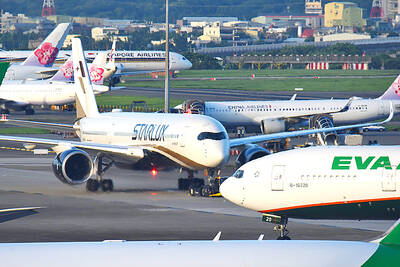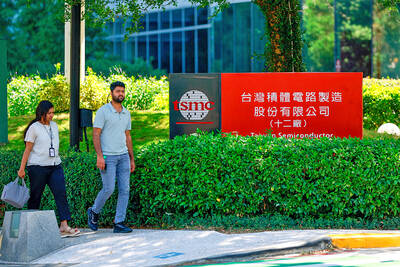Largan Precision Co (大立光電), a leading maker of camera lenses, expects growth to pick up in the final quarter of this year, helped by rising shipments of high-margin products and improving handset demand, a company executive said yesterday.
"We believe the third quarter will be our worst," chairman Lin Yao-yin (林耀英) told an investor's conference yesterday.
With new orders pouring in and increasing shipments of advanced lenses for higher mexapixel camera phones, Lin said "the fourth quarter could be the strongest period for Largan."
"We have no reason to be pessimistic [about the second half] as we already saw some positive signs from our customers," he said.
Largan, which supplies glass and plastic lenses for digital cameras and multifunctional printers, is counting on the mobile-phone industry for growth.
Its major customers include Nokia Ojy and LiteOn Technology Corp (光寶).
Lin's positive outlook came after Largan reported a lower second-quarter results amid gloomy prospects for handsets and digital cameras, which together make up a hefty 60 percent of the Taichung-based company's total sales.
Largan's second-quarter earnings fell nearly 13 percent to NT$312.9 million, or NT$2.88 a share, from NT$378.02 million three months ago.
Its gross margin fell 7 percent during the April to June period, dropping from 59 percent in the previous quarter to 51.6 percent, Largan said.
Company spokesman Charles Chiu (邱東泉), however, said he is confident the firm will achieve this year's financial forecast of NT$1.55 billion in earnings, or NT$14.38 a share.
But the mobile-phone segment's contribution to sales will fall from the company's previous estimate of 40 percent to around 35 percent, he said.
In the first half of the year, earnings climbed to NT$665.52 million, or NT$6.2 per share, up 43 percent from NT$444.95 million a year ago.
Lin said high-margin lens and phone modules for camera phones with megapixel resolution are expected to grow to make up 50 percent of the company's shipments from current 10 percent.
"The new products will offset the lukewarm demand for handsets and become a major engine to drive Largan's profits," said Ken Yu (
Advanced lenses have a 50-percent higher gross margin than VGA-resolution screens, which are now commonly used in digital cameras, or camera phones, Yu said.
Largan is planning to ship 20 million camera lenses and modules this year.
That figure, however, is lower than the estimate of 34 million units projected by an analyst with a US-based investment bank who requested not to be named.
"The lower-than-expected figure provides evidence that mounting inventory remains an issue for handset sector," the analyst said.
Largan shares advanced by 4.41 percent to close at NT$213 on the TAIEX yesterday.

RECYCLE: Taiwan would aid manufacturers in refining rare earths from discarded appliances, which would fit the nation’s circular economy goals, minister Kung said Taiwan would work with the US and Japan on a proposed cooperation initiative in response to Beijing’s newly announced rare earth export curbs, Minister of Economic Affairs Kung Ming-hsin (龔明鑫) said yesterday. China last week announced new restrictions requiring companies to obtain export licenses if their products contain more than 0.1 percent of Chinese-origin rare earths by value. US Secretary of the Treasury Scott Bessent on Wednesday responded by saying that Beijing was “unreliable” in its rare earths exports, adding that the US would “neither be commanded, nor controlled” by China, several media outlets reported. Japanese Minister of Finance Katsunobu Kato yesterday also

China Airlines Ltd (CAL, 中華航空) said it expects peak season effects in the fourth quarter to continue to boost demand for passenger flights and cargo services, after reporting its second-highest-ever September sales on Monday. The carrier said it posted NT$15.88 billion (US$517 million) in consolidated sales last month, trailing only September last year’s NT$16.01 billion. Last month, CAL generated NT$8.77 billion from its passenger flights and NT$5.37 billion from cargo services, it said. In the first nine months of this year, the carrier posted NT$154.93 billion in cumulative sales, up 2.62 percent from a year earlier, marking the second-highest level for the January-September

‘DRAMATIC AND POSITIVE’: AI growth would be better than it previously forecast and would stay robust even if the Chinese market became inaccessible for customers, it said Taiwan Semiconductor Manufacturing Co (TSMC, 台積電) yesterday raised its full-year revenue growth outlook after posting record profit for last quarter, despite growing market concern about an artificial intelligence (AI) bubble. The company said it expects revenue to expand about 35 percent year-on-year, driven mainly by faster-than-expected demand for leading-edge chips for AI applications. The world’s biggest contract chipmaker in July projected that revenue this year would expand about 30 percent in US dollar terms. The company also slightly hiked its capital expenditure for this year to US$40 billion to US$42 billion, compared with US$38 billion to US$42 billion it set previously. “AI demand actually

Jensen Huang (黃仁勳), founder and CEO of US-based artificial intelligence chip designer Nvidia Corp and Taiwan Semiconductor Manufacturing Co (TSMC, 台積電) on Friday celebrated the first Nvidia Blackwell wafer produced on US soil. Huang visited TSMC’s advanced wafer fab in the US state of Arizona and joined the Taiwanese chipmaker’s executives to witness the efforts to “build the infrastructure that powers the world’s AI factories, right here in America,” Nvidia said in a statement. At the event, Huang joined Y.L. Wang (王英郎), vice president of operations at TSMC, in signing their names on the Blackwell wafer to